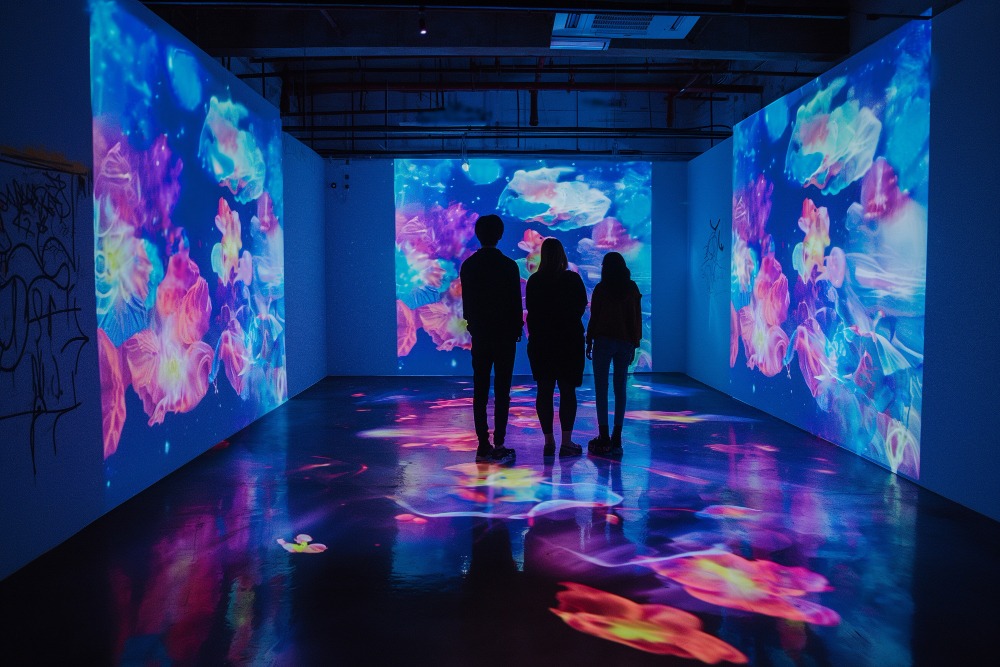The art world has always been about innovation and pushing the boundaries of creative expression. With the rise of virtual art galleries, technology and creativity have intertwined to create a new era in art viewing. In 2024, virtual art galleries have become a significant medium for both artists and art enthusiasts to connect, explore, and enjoy art without geographic limitations. In this comprehensive guide, we’ll dive into the world of virtual art galleries, examining their evolution, benefits, and what makes them essential to the future of art.
What Are Virtual Art Galleries?
A virtual art gallery is an online platform where artworks are exhibited in a digital format. These galleries can range from simple online displays of images to highly interactive, immersive experiences with 3D rooms, AR, and VR capabilities. Unlike traditional art galleries, virtual art galleries remove geographic barriers and make art accessible to anyone with an internet connection.
Virtual art galleries have become popular for their accessibility, convenience, and versatility, allowing users to explore and experience art from their devices, wherever they are in the world.
The Rise of Virtual Art Galleries
The trend of virtual art galleries began in the early 2000s but surged significantly in the wake of the COVID-19 pandemic when lockdowns forced physical galleries to close. This move to digital opened up opportunities for artists and curators to showcase work in an online environment. According to recent reports, over 60% of art collectors are now comfortable purchasing art online, a substantial increase from previous years.
In 2024, virtual art galleries are more advanced than ever. With enhanced technology, platforms offer seamless virtual walkthroughs, interactive features, and multi-dimensional viewing options that mimic in-person experiences, making art more accessible to a global audience.
How Virtual Art Galleries Work
Virtual art galleries use various technologies, including:
- 3D Modeling: Enables the creation of life-like, walk-through environments.
- Augmented Reality (AR): Allows users to see how an artwork would look in their space.
- Virtual Reality (VR): Offers immersive viewing experiences.
- Blockchain & NFTs: Many galleries utilize blockchain to ensure the authenticity and ownership of digital artwork.
These technologies provide an engaging and interactive way for visitors to experience art online. Users can view artworks, zoom in for details, read artist descriptions, and even engage in live chats with artists or curators.
Advantages of Virtual Art Galleries for Artists and Collectors
Virtual art galleries offer several unique benefits:
For Artists:
- Increased Reach: Artists can connect with global audiences without the limitations of physical space.
- Lower Costs: Artists save on shipping and framing costs, as works can be displayed digitally.
- 24/7 Availability: Artwork can be viewed at any time, broadening the exposure window.
- Direct Sales Opportunities: Virtual galleries often integrate e-commerce, allowing artists to sell directly to collectors.
For Collectors:
- Convenience: Art collectors can view and purchase artwork from anywhere in the world.
- Diverse Selections: Virtual galleries often feature emerging artists alongside established names, providing a wide range of options.
- Transparency & Provenance: Blockchain technology in virtual galleries ensures transparency and traceability for digital art purchases.
- Cost-Effective: Virtual tours and exhibitions eliminate travel expenses, making it affordable to explore new artists and trends.
Top Virtual Art Gallery Platforms in 2024
- Artland: Artland has developed a platform that combines the social aspects of art with digital viewing experiences. It features high-quality virtual exhibitions and allows users to interact with artists and collectors.
- Kunstmatrix:Kunstmatrix is known for its user-friendly interface and 3D visualization features, ideal for artists and galleries wanting to create immersive digital exhibits without requiring technical expertise.
- Vortic:Vortic uses augmented reality to bring artworks to life, allowing collectors to experience art as if they were standing in a physical gallery.
- VR-All-Art:VR-All-Art leverages virtual reality to create a fully immersive gallery experience. Users can navigate through 3D spaces and engage with art in VR environments.
- Spatial:Spatial is a platform that allows artists to showcase their work in customizable 3D spaces. It’s highly popular for collaborative exhibitions, bringing together artists, curators, and collectors.
Virtual vs. Physical Art Galleries: Key Differences
| Aspect | Virtual Art Galleries | Physical Art Galleries |
| Accessibility | Global access, 24/7 availability | Limited to specific locations and operating hours |
| Cost for Artists | Lower (no shipping, framing, or setup costs) | Higher (includes setup, travel, and exhibition fees) |
| Viewer Experience | Immersive but lacks physical interaction with art | Direct engagement with the art pieces |
| Customization | High, with varied 3D/VR/AR tools | Limited to the gallery’s physical space and design |
| Environmental Impact | Reduced (no travel or physical resources needed) | Higher environmental footprint |
The Future of Virtual Art Galleries: Trends to Watch
As technology advances, virtual art galleries are expected to evolve in several exciting ways:
- Enhanced Virtual Reality Experiences: VR headsets are becoming more affordable and accessible, enabling more immersive virtual tours.
- Augmented Reality for In-Home Viewing: As AR continues to advance, users can view art in their own spaces to see how a piece would look before buying.
- NFT Integration for Ownership and Authenticity: Non-fungible tokens (NFTs) are becoming common in virtual galleries, allowing for digital ownership and investment.
- AI-Driven Curation and Recommendations: AI will allow virtual galleries to provide personalized recommendations based on users’ viewing habits and preferences.
- Social Interaction Features: Virtual galleries are incorporating social media and interactive elements, allowing users to engage and discuss art directly on the platform.
How to Start Your Own Virtual Art Gallery
Starting a virtual art gallery requires thoughtful planning and investment in the right technology. Here are some steps to get started:
- Choose a Platform: Decide if you want to use an existing platform like Kunstmatrix or create a custom gallery from scratch.
- Select Artworks to Display: Curate a selection of works that fit the theme or purpose of your gallery.
- Utilize 3D or VR/AR Tools: Invest in software or platforms that offer 3D modeling, VR, or AR options to enhance the user experience.
- Build a Website or Gallery Page: Create a website to host your gallery and integrate it with social media for broader reach.
- Promote Your Gallery: Use social media, digital advertising, and online art communities to spread the word about your gallery launch.
Conclusion
Virtual art galleries have emerged as a revolutionary addition to the art world, bridging gaps and breaking down barriers that once limited art access and appreciation. In 2024, they provide an immersive, global platform for artists and collectors, offering benefits that traditional galleries simply cannot match—from accessibility and cost-effectiveness to environmental sustainability. By harnessing advanced technologies like VR, AR, and blockchain, virtual galleries create rich, interactive experiences that mirror the magic of in-person viewing while making art more accessible than ever.
As virtual galleries continue to evolve, they are poised to become a permanent fixture in the art world, complementing physical spaces and enhancing how we experience and collect art. For artists, collectors, and art lovers alike, virtual galleries are not just a temporary solution; they represent a powerful, enduring transformation that invites us all to explore, connect with, and celebrate art on a global scale.


